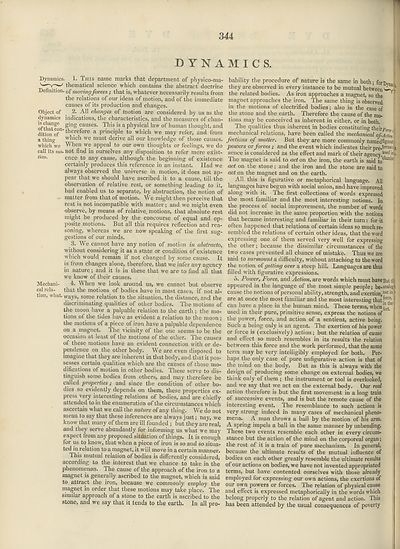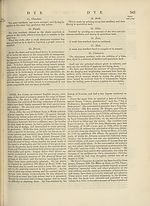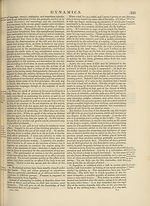Encyclopaedia Britannica > Volume 8, DIA-England
(354) Page 344 - Dynamics
Download files
Complete book:
Individual page:
Thumbnail gallery: Grid view | List view

344
DYNAMICS.
Dynamics. 1. This name marks that department of physico-ma-
thematical science which contains the abstract doctrine
Definition. 0f moving forces ; that is, whatever necessarily results from
the relations of our ideas of motion, and of the immediate
causes of its production and changes.
Object of 2. All changes of motion are considered by us as the
dynamics indications, the characteristics, and the measures of chan-
ging causes. This is a physical law of human thought, and
dition of”" t*le.re^ore a principle to which we may refer, and from
a thing which we must derive all our knowledge of those causes,
which we When we appeal to our own thoughts or feelings, we do
call its mo- not find in ourselves any disposition to refer mere exist-
tion. ence to any cause, although the beginning of existence
certainly produces this reference in an instant. Had we
always observed the universe in motion, it does not ap¬
pear that we should have ascribed it to a cause, till the
observation of relative rest, or something leading to it,
had enabled us to separate, by abstraction, the notion of
matter from that of motion. We might then perceive that
rest is not incompatible with matter; and we might even
observe, by means of relative, motions, that absolute rest
might be produced by the concourse of equal and op¬
posite motions. But all this requires reflection and rea¬
soning, whereas we are now speaking of the first sug¬
gestions of our minds.
3. We cannot have any notion of motion in abstracto,
without considering it as a state or condition of existence
which would remain if not changed by some cause. It
is from changes alone, therefore, that we infer any agency
in nature; and it is in these that we are to find all that
wre know of their causes.
Median!- 4. When we look around us, we cannot but observe
calrela- that the motions of bodies have in most cases, if not al-
tion, what. wayS> some relation to the situation, the distance, and the
discriminating qualities of other bodies. The motions of
the moon have a palpable relation to the earth ; the mo¬
tions of the tides have as evident a relation to the moon;
the motions of a piece of iron have a palpable dependence
on a magnet. Ihe vicinity of the one seems to be the
occasion at least of the motions of the other. The causes
of these motions have an evident connection with or de¬
pendence on the other body. We are even disposed to
imagine that they are inherent in that body, and that it pos¬
sesses certain qualities which are the causes of those mo¬
difications of motion in other bodies. These serve to dis¬
tinguish some bodies from others, and may therefore be
called properties; and since the condition of other bo¬
dies so evidently depends on them, these properties ex¬
press very interesting relations of bodies, and are chiefly
attended to in the enumeration of the circumstances which
ascertain what we call the nature of any thing. We do not
mean to say that these inferences are always just; nay, we
know that many of them are ill founded ; but they are real,
and they serve abundantly for informing us what we may
expect from any proposed situation of things. It is enough
for us to know, that when a piece of iron is so and so situa¬
ted in relation to a magnet, it will move in a certain manner.
This mutual relation of bodies is differently considered,
according to the interest that we chance to take in the
phenomenon. The cause of the approach of the iron to a
magnet is generally ascribed to the magnet, which is said
to attract the iron, because we commonly employ the
magnet in order that these motions may take place. The
similar approach of a stone to the earth is ascribed to the
stone, and we say that it tends to the earth. In all pro¬
bability the procedure of nature is the same in both; forD-
they are observed in every instance to be mutual between Wy
the related bodies. As iron approaches a magnet, so the '
magnet approaches the iron. The same thing is observed
in the motions of electrified bodies; also in the case of
the stone and the earth. Therefore the cause of the mo¬
tions may be conceived as inherent in either, or in both.
The qualities thus inherent in bodies constituting their^,
mechanical relations, have been called the mechanical at-Action
fections of matter. But they are more commonly named%urat
powers or forces ; and the event which indicates their pre-teriM' i
sence is considered as the effect and mark of their agency.used.1,1
The magnet is said to act on the iron, the earth is said tochanisi
act on the stone; and the iron and the stone are said to
act on the magnet and on the earth.
All this is figurative or metaphorical language. All
languages have begun with social union, and have improved
along with it. The first collections of words expressed
the most familiar and the most interesting notions. In
the process of social improvement, the number of words
did not increase in the same proportion with the notions
that became interesting and familiar in their turn: for it
often happened that relations of certain ideas so much re¬
sembled the relations of certain other ideas, that the word
expressing one of them served very well for expressing
the other; because the dissimilar circumstances of the
two cases prevented all chance of mistake. Thus we are
said to surmount a difficulty, without attaching to the word
the notion of getting over a steep hill. Languages are thus
filled with figurative expressions.
5. Power, Force, and Action, are words which must haveButtl
appeared in the language of the most simple people; be-analog
cause the notions of personal ability, strength, and exertion,not in
are at once the most familiar and the most interesting that!orcf’
can have a place in the human mind. These terms, whenj^j 6
used in their pure, primitive sense, express the notions of
the power, force, and action of a sentient, active being.
Such a being only is an agent. The exertion of his power
or force is (exclusively) action; but the relation of cause
and effect so much resembles in its results the relation
between this force and the work performed, that the same
term may be very intelligibly employed for both. Per¬
haps the only case of pure unfigurative action is that of
the mind on the body. But as this is always with the
design of producing some change on external bodies, we
think only of them ; the instrument or tool is overlooked,
and we say that we act on the external body. Our real
action therefore is but the first movement in a long train
of successive events, and is but the remote cause of the
interesting event. The resemblance to such actions is
very strong indeed in many cases of mechanical pheno¬
mena. A man throws a ball by the motion of his arm.
A spring impels a ball in the same manner by unbending.
These two events resemble each other in every circum¬
stance but the action of the mind on the corporeal organ;
the rest of it is a train of pure mechanism. In general,
because the ultimate results of the mutual influence of
bodies on each other greatly resemble the ultimate results
of our actions on bodies, we have not invented appropriated
terms, but have contented ourselves with those already
employed for expressing our own actions, the exertions of
our own powers or forces. The relation of physical cause
and effect is expressed metaphorically in the words which
belong properly to the relation of agent and action. This
has been attended by the usual consequences of poverty
DYNAMICS.
Dynamics. 1. This name marks that department of physico-ma-
thematical science which contains the abstract doctrine
Definition. 0f moving forces ; that is, whatever necessarily results from
the relations of our ideas of motion, and of the immediate
causes of its production and changes.
Object of 2. All changes of motion are considered by us as the
dynamics indications, the characteristics, and the measures of chan-
ging causes. This is a physical law of human thought, and
dition of”" t*le.re^ore a principle to which we may refer, and from
a thing which we must derive all our knowledge of those causes,
which we When we appeal to our own thoughts or feelings, we do
call its mo- not find in ourselves any disposition to refer mere exist-
tion. ence to any cause, although the beginning of existence
certainly produces this reference in an instant. Had we
always observed the universe in motion, it does not ap¬
pear that we should have ascribed it to a cause, till the
observation of relative rest, or something leading to it,
had enabled us to separate, by abstraction, the notion of
matter from that of motion. We might then perceive that
rest is not incompatible with matter; and we might even
observe, by means of relative, motions, that absolute rest
might be produced by the concourse of equal and op¬
posite motions. But all this requires reflection and rea¬
soning, whereas we are now speaking of the first sug¬
gestions of our minds.
3. We cannot have any notion of motion in abstracto,
without considering it as a state or condition of existence
which would remain if not changed by some cause. It
is from changes alone, therefore, that we infer any agency
in nature; and it is in these that we are to find all that
wre know of their causes.
Median!- 4. When we look around us, we cannot but observe
calrela- that the motions of bodies have in most cases, if not al-
tion, what. wayS> some relation to the situation, the distance, and the
discriminating qualities of other bodies. The motions of
the moon have a palpable relation to the earth ; the mo¬
tions of the tides have as evident a relation to the moon;
the motions of a piece of iron have a palpable dependence
on a magnet. Ihe vicinity of the one seems to be the
occasion at least of the motions of the other. The causes
of these motions have an evident connection with or de¬
pendence on the other body. We are even disposed to
imagine that they are inherent in that body, and that it pos¬
sesses certain qualities which are the causes of those mo¬
difications of motion in other bodies. These serve to dis¬
tinguish some bodies from others, and may therefore be
called properties; and since the condition of other bo¬
dies so evidently depends on them, these properties ex¬
press very interesting relations of bodies, and are chiefly
attended to in the enumeration of the circumstances which
ascertain what we call the nature of any thing. We do not
mean to say that these inferences are always just; nay, we
know that many of them are ill founded ; but they are real,
and they serve abundantly for informing us what we may
expect from any proposed situation of things. It is enough
for us to know, that when a piece of iron is so and so situa¬
ted in relation to a magnet, it will move in a certain manner.
This mutual relation of bodies is differently considered,
according to the interest that we chance to take in the
phenomenon. The cause of the approach of the iron to a
magnet is generally ascribed to the magnet, which is said
to attract the iron, because we commonly employ the
magnet in order that these motions may take place. The
similar approach of a stone to the earth is ascribed to the
stone, and we say that it tends to the earth. In all pro¬
bability the procedure of nature is the same in both; forD-
they are observed in every instance to be mutual between Wy
the related bodies. As iron approaches a magnet, so the '
magnet approaches the iron. The same thing is observed
in the motions of electrified bodies; also in the case of
the stone and the earth. Therefore the cause of the mo¬
tions may be conceived as inherent in either, or in both.
The qualities thus inherent in bodies constituting their^,
mechanical relations, have been called the mechanical at-Action
fections of matter. But they are more commonly named%urat
powers or forces ; and the event which indicates their pre-teriM' i
sence is considered as the effect and mark of their agency.used.1,1
The magnet is said to act on the iron, the earth is said tochanisi
act on the stone; and the iron and the stone are said to
act on the magnet and on the earth.
All this is figurative or metaphorical language. All
languages have begun with social union, and have improved
along with it. The first collections of words expressed
the most familiar and the most interesting notions. In
the process of social improvement, the number of words
did not increase in the same proportion with the notions
that became interesting and familiar in their turn: for it
often happened that relations of certain ideas so much re¬
sembled the relations of certain other ideas, that the word
expressing one of them served very well for expressing
the other; because the dissimilar circumstances of the
two cases prevented all chance of mistake. Thus we are
said to surmount a difficulty, without attaching to the word
the notion of getting over a steep hill. Languages are thus
filled with figurative expressions.
5. Power, Force, and Action, are words which must haveButtl
appeared in the language of the most simple people; be-analog
cause the notions of personal ability, strength, and exertion,not in
are at once the most familiar and the most interesting that!orcf’
can have a place in the human mind. These terms, whenj^j 6
used in their pure, primitive sense, express the notions of
the power, force, and action of a sentient, active being.
Such a being only is an agent. The exertion of his power
or force is (exclusively) action; but the relation of cause
and effect so much resembles in its results the relation
between this force and the work performed, that the same
term may be very intelligibly employed for both. Per¬
haps the only case of pure unfigurative action is that of
the mind on the body. But as this is always with the
design of producing some change on external bodies, we
think only of them ; the instrument or tool is overlooked,
and we say that we act on the external body. Our real
action therefore is but the first movement in a long train
of successive events, and is but the remote cause of the
interesting event. The resemblance to such actions is
very strong indeed in many cases of mechanical pheno¬
mena. A man throws a ball by the motion of his arm.
A spring impels a ball in the same manner by unbending.
These two events resemble each other in every circum¬
stance but the action of the mind on the corporeal organ;
the rest of it is a train of pure mechanism. In general,
because the ultimate results of the mutual influence of
bodies on each other greatly resemble the ultimate results
of our actions on bodies, we have not invented appropriated
terms, but have contented ourselves with those already
employed for expressing our own actions, the exertions of
our own powers or forces. The relation of physical cause
and effect is expressed metaphorically in the words which
belong properly to the relation of agent and action. This
has been attended by the usual consequences of poverty
Set display mode to:
![]() Universal Viewer |
Universal Viewer | ![]() Mirador |
Large image | Transcription
Mirador |
Large image | Transcription
Images and transcriptions on this page, including medium image downloads, may be used under the Creative Commons Attribution 4.0 International Licence unless otherwise stated. ![]()
| Encyclopaedia Britannica > Encyclopaedia Britannica > Volume 8, DIA-England > (354) Page 344 - Dynamics |
|---|
| Permanent URL | https://digital.nls.uk/193327607 |
|---|
| Attribution and copyright: |
|
|---|
| Description | Ten editions of 'Encyclopaedia Britannica', issued from 1768-1903, in 231 volumes. Originally issued in 100 weekly parts (3 volumes) between 1768 and 1771 by publishers: Colin Macfarquhar and Andrew Bell (Edinburgh); editor: William Smellie: engraver: Andrew Bell. Expanded editions in the 19th century featured more volumes and contributions from leading experts in their fields. Managed and published in Edinburgh up to the 9th edition (25 volumes, from 1875-1889); the 10th edition (1902-1903) re-issued the 9th edition, with 11 supplementary volumes. |
|---|---|
| Additional NLS resources: |
|

